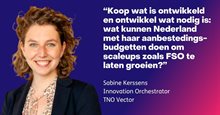Guidance for targeted measures
The above are some of the findings in TNO's report 'Towards a sovereign digital future – the Netherlands in Europe'. For the report, experts inside and outside TNO were consulted, and extensive interviews were held with CIOs from both multinationals and SMEs. It includes a study of digital transformation developments in Europe and provides policymakers and industry with guidance on taking targeted measures to reduce their dependence on a limited number of parties outside our continent.
Curious about the report?
In the report 'Towards a sovereign digital future' we provide an overview of the level of digital sovereignty for Europe and the Netherlands based on the various digital technology layers of a stack model.
Operating from strengths
‘Developments in this area are so rapid that it’s becoming increasingly complex for governments to provide a detailed response to what they consider undesirable.
We’re far too dependent on a limited number of technology suppliers and cloud providers outside Europe. Policies and regulations to enhance digital sovereignty are being rapidly developed, but that does not constitute a quick fix. We also need to operate much more based on our strengths,’ says TNO expert Claire Stolwijk.
Standing out on a global scale
‘Take the development of mobile communications,’ says co-author Matthijs Punter. ‘In the days of GSM and 3G, the EU was in the lead. This is where we set the standards, and this is where the big network builders and device manufacturers were located. We have largely lost that position to Asia and the US.
For this reason, TNO has initiated the Future Network Services (FNS) programme, in which we aim to set the standard for 6G in a consortium with some 60 European partners. We’re therefore once again at the forefront of new technological developments that will allow us to stand out on a global scale.’
Layer model
The report builds on an earlier study on digital sovereignty from 2022 [download]. The new study gives an up-to-date overview of the current situation in this field in Europe, based on economic, societal, security, and business perspectives.
To understand the technological developments and desired responses, we used what is called a layer model. For each layer, the study worked out where the EU stands compared to other locations in the world in terms of R&D and from a market perspective.
It also identified for each layer what policies and regulation are currently in place to strengthen digital sovereignty. The model involves layers such as infrastructure for hardware and software, chips and microchips, networks and connectivity, cloud and edge infrastructure, intelligence, data, data sharing, applications, and user interfaces.
Strength and weakness analysis
The digital technologies of these layers are related to four scenarios to visualise what the digital world looks like now and show what actions can be taken to bring about a change in the current situation. The scenarios involve open international collaboration, competitive coalitions, the dominance of big tech and a unilateral approach, with trade wars between the major economic power blocs.
The above-mentioned trade wars appear to be the worst-case scenario for Europe, while open international collaboration offers the most opportunities. It means fewer one-sided dependencies on a small number of non-European suppliers.
With regard to various digital technologies, Europe currently finds itself in the scenario of big tech dominance, which is almost exclusively the domain of hyperscalers from the US, where some 90% of Western data is stored. This is where we should develop a robust digital European infrastructure as an alternative, which also allows space for smaller cloud service providers. This would make companies, organisations, and public authorities less dependent on providers outside Europe and also ensure that data are stored and exchanged according to European values and standards.
Becoming world leader
‘In our research, we talk about control points, that is to say companies or technologies that have a strong position internationally. Players in the value chain that actually or potentially belong to the world's leaders. In the Netherlands, we’re strong in developing quantum technology, and we’re working on the aforementioned 6G. We must be fully committed to those fields.
A major financial injection from a national growth fund or EU IPCEI will have to be accompanied by long-term investment by public authorities and industry to make this a success. In addition to policy and regulation, we’re developing new technologies within the EU, and it will then be a matter of ensuring that those technologies conquer the global market, to create new business activity and prosperity in Europe,’ the TNO experts conclude.
Contact us:





